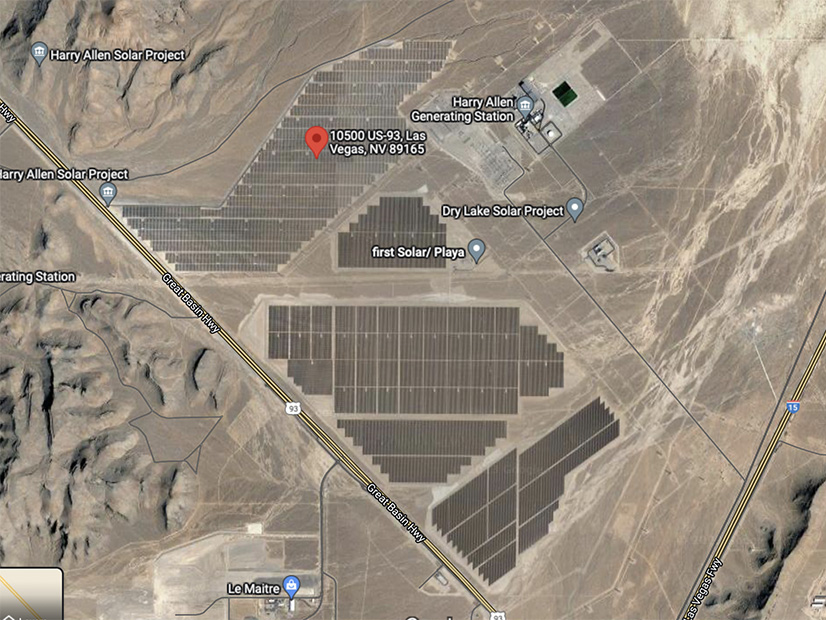
The man arrested last week in Las Vegas for damaging a major solar facility told police he had “no regret” over the incident and that the destruction of his car was necessary “for the future,” according to the police report shared with ERO Insider.
Officers with the Las Vegas Metropolitan Police arrested 34-year-old Mohammad Mesmarian last Wednesday on charges of terrorism, arson, destruction of property and attempting to escape police custody. The officers said Mesmarian, a native of Iran, acted alone.
 The booking photo of Mohammad Mesmarian | Las Vegas Metropolitan Police Department
The booking photo of Mohammad Mesmarian | Las Vegas Metropolitan Police DepartmentMesmarian allegedly burned his car at the Dry Lake Solar Plant, a 700-acre facility northeast of Las Vegas also known as the Mega Solar Array. The facility, which is operated by Invenergy, provides about 95% of the daily electricity needs for MGM Resorts’ Las Vegas properties, although the incident left it out of commission. An Invenergy spokesperson told ERO Insider that the plant is expected to be fully operational later this week.
Based on what he told police, as summarized in the report, it’s unclear whether Mesmarian actually knew what the array does, as he said he supports clean energy and wanted to destroy his car because it represented old, polluting technology.
“Mesmarian believes in harmony between species and does not approve of old forms of energy,” the report says. “Mesmarian indicated he burned the vehicle because it uses gasoline and oil, as well as produces carbon emissions.”
Employees Gone when Incident Occurred
The police report says Mesmarian drove his car, a red Toyota Camry with an Idaho license plate, through the security fence at the facility around 3:30 p.m. on Jan. 3. Employees were not present at the time, having left around 2:30 after completing a final site check for the day. Mesmarian then tried to drive through the security gate surrounding the plant’s main transformer, but his car got stuck. He used some tools to cut a wide enough opening to get in.
Once inside the transformer area, Mesmarian wandered around a bit; surveillance footage showed him apparently taking photos of the transformer and control house, turning some switches off and trying to get into the control room. Around midnight he drilled a hole in the car’s gas tank and soaked a rag with gasoline. He then put the rag in the engine compartment and used jumper cables to ignite it.
After the rag caught the rest of the engine compartment on fire, Mesmarian was able to get the car moving and watched as it entered the concrete retention pit beneath the transformer. He then sat in a chair and continued to watch the car burn until around 12:30 a.m., when he left.
Burned Phone Leads to Suspect
Employees began to arrive at the Dry Lake plant’s administrative offices around 6 the following morning but didn’t discover the damage and the remains of the car until around 11:30. That was when the site manager received his new credentials for the security system. Upon logging in, the manager realized there was a car smoldering in the concrete pit and directed the other employees to respond. After they put out the remaining embers, an employee called police; detectives from the counterterrorism unit were sent to investigate.
The car was too badly burned to find a license plate or vehicle identification number, but the detectives found a damaged iPhone in the back seat; after contacting Apple with the device’s IMEI number — which is unique to each phone — officers discovered that it was connected to an account in Mesmarian’s name. Officers then discovered Mesmarian’s Instagram account, which showed pictures purportedly taken in Arizona several days earlier of someone who looked like the person in the surveillance footage, wearing similar clothing.
Before the destruction was discovered, Mesmarian had actually had a run-in with police around 8 a.m., when employees of a nearby waste disposal site reported him trespassing. Reviewing video from the officers’ body cameras, detectives saw that Mesmarian was still wearing the clothes he apparently wore during the incident at the solar facility. During the encounter Mesmarian told officers he was in town with his mother, named Deborah, and worked odd jobs. The report does not say what police did, if anything, about the trespassing incident.
Staff at the waste site told detectives that Mesmarian had also been there the day before, driving a red Camry. They showed police photos of the car, which had an Idaho license plate registered to Deborah Mesmarian.
Police were able to track Mesmarian to a camping area, where they found him in a travel trailer bearing an Idaho plate. They took him into custody without incident, although he later tried to run away twice; both times officers were able to restrain him.
Confused Story from Accused
During his interrogation, Mesmarian described his memory of his acts at the solar facility. The account corresponded closely to the surveillance video, but he appeared confused on some elements. For example, he seemed to believe the plant was built or run by Tesla, and he initially referred to the transformer as a “computer” before being corrected by detectives.
It’s also unclear how Mesmarian got the car to move after lighting the engine compartment on fire. The incident report says he placed an object on the accelerator, but under interrogation, he said that didn’t work and had to jump out of the car while it was moving.
Regarding his motive, Mesmarian said he intended to burn the car — which he said belonged to his grandmother — as a protest against old, polluting technology. He got the idea while working on the car on New Year’s Eve, a few days after he arrived in Las Vegas, he said.
Mesmarian told detectives he “believed in clean sources of energy and was against carbon [emissions], as well as oil and coal energy.” Burning the car, he believed, would send a message to the public to “let go of the old forms of energy,” along with freeing him personally from “harmful memories of his past.” Asked if he would do the same thing again if he could go back in time before the incident, Mesmarian said, “Oh yeah. … No regret.”
Despite having no training related to electrical systems, Mesmarian believed he had made the facility “safe” by turning off the switches before he set the car on fire and denied that he was trying to sabotage it. When detectives pointed out that setting the fire inside the solar plant was dangerous, he told them he “figured [that] had been thought [of] ahead of time.” When further pressed he admitted that he knew he could have damaged the unit but that he did it for the greater good.
According to reports from local media, Mesmarian behaved erratically at a court appearance on Tuesday, interrupting other defendants’ proceedings to complain about the justice system to the point where the judge ordered him escorted out. During a hearing, for which Mesmarian was let back in, the judge ordered him to undergo a psychiatric evaluation ahead of a Jan. 31 appearance in state court.
Electric Attacks Continue
Mesmarian’s actions are at least the third high-profile disruption of U.S. electric facilities in a month. At the beginning of December, attackers damaged two substations run by Duke Energy in Moore County, N.C., with rifles, leaving 45,000 customers without power for days; no suspects have been identified and their motive is unknown. (See Duke Completes Power Restoration After NC Substation Attack.)
Later in the month four electric substations in Washington state were broken into and damaged on Christmas morning, cutting power to about 15,000 customers. The Justice Department has charged two men with carrying out all four attacks to cover up a burglary plot. (See Feds Charge Two in Wash. Substation Sabotage.)


